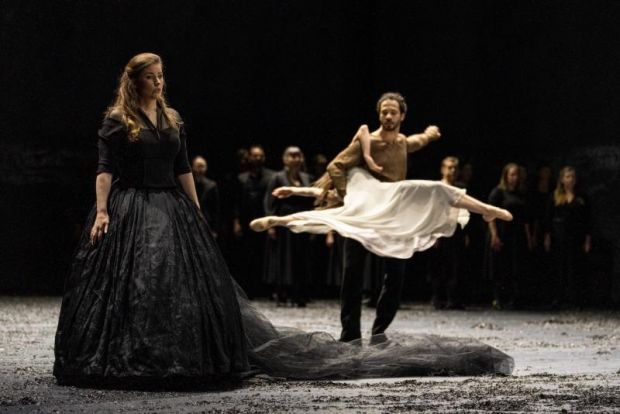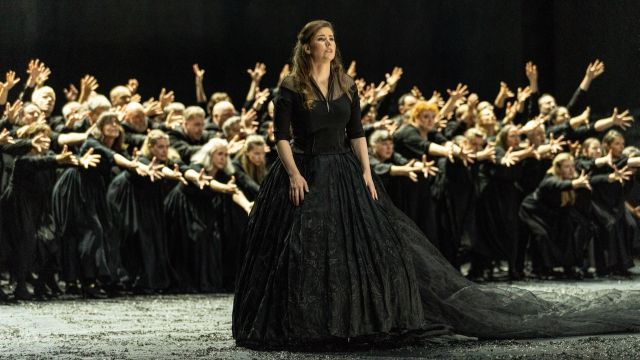Messa Da Requiem
Alone, Verdi’s famous oratorio is a vibrant, stirring musical work. Paired with sublime choreography, the exceptional dancers from Ballett Zürich, and an enormous precisely choreographed chorus, it is a master work.
Usually experienced in concert form, an oratorio presents as a large-scale musical composition with a sacred or semi-sacred subject for solo voices, chorus, and orchestra. Verdi premiered his Requiem in 1874 on the first anniversary of friend and author Alessandro Manzoni’s death. Oft-awarded choreographer Christian Spuck has been the Artistic Director of Ballett Zürich since the 2012/13 season and his multi-disciplinary Messa Da Requiem was first performed in Zurich in 2016.

Ballett Zürich is a company of 36 dancers known for stylistic diversity and featuring works from the classical repertoire as well as modern dance. The choreography for Requiem reflected this range on many levels: the use of pointe shoes as well soft ballet slippers, the flexed feet of the dancers for some motifs, compelling floor work that flowed effortlessly through to aerial leaps, athletic and sometimes grotesque or angular pas de deux or chorus movement, great variety of ‘facings’ including the use of the colossal set ‘walls’ giving us a skewed perspective or sometimes several perspectives at once.

Spruck explains that during the creation phase of the work, he and original conductor Fabio Luisi decided against using movement language to tell any stories around loss, of the life of the subject Manzoni, or about the Italian Risorgimento (Italy’s unification in the 19th Century); they agreed the movement would remain abstract as to do anything else would ‘disrespect’ the music. So the choreography is impressionistic in form, at times the embodying the music in all its variation, or else as a response to the emotional dynamics of the score and voices. One startling image (of so many) sees several dancer couples executing a synchronised lift amid the 170 strong chorus of singers, the startling upward thrust of bodies out of the motionless black-clad crowd soaring with the music. There are many such instances of beauty and grandeur, the dance and the song existing separately but related in tone.

Flow is quite a feature of this work. Assembled expressly for this iteration, the exemplary Adelaide Festival Chorus is required to move through and around the performance space in fast transits across the stage, complex groupings with arms moving furiously, or arranged in solemn groups around the edges, as well as timely entrances and exits that materialize in the dark, gloomy lighting states; all this as they sing with passion and perfect pitch. Sections where the chorus merged with dancers or soloists in undulating choreographed tableaux are thrilling as are scenes where the dancers align closely to elongate the presence of a solo singer, or perhaps echo the notes they are pouring forth.

During the second night performance I attended, the soloists were compelling to watch and thrilling to hear. Soprano Eleanor Lyons, Mezzo Soprano Caitlin Hulcup, Tenor Paul O’Neill, and Bass Pelham Andrews all brought both vocal skill and solemn grandeur to the work. They delivered demanding solos and group material throughout and undertook the choreographed positioning gracefully and with ease. The complexity and enormity of Messa Da Requiem is impossible to impart in a short review. Scene after scene of great beauty and striking imagery followed in quick succession overlaid with the exhilarating sound of so many voices and the exquisite choreography. I will however, never forget the virtuosity of Eleanor Lyons. Her range and nuance, her command of vocal power and poignancy was breathtaking.

The vast monotone set by Christian Schmidt was daunting in size yet indicated a neutral, possibly transitory space where emotions might be given free rein, then abandoned. Martin Gebhardt’s subtle lighting moved from cool to warm, mostly at a low level, and was completely apt for the tone of the whole. A sole figure manipulated a grounded spotlight to throw dancers’ magnified shadows across the set in one section and at other times, fine downlights picked out the dancers among the chorus, setting them in contrast to the singers in black. Emma Ryott’s costumes were monotone, blacks, and a variety of earthy tones for some dancers. The styles ranged from casual, to elegant, to dramatic, climaxing with Eleanor Lyons appearing in a confection of exaggerated black tulle similar to what some dancers wore earlier in the piece as they traversed the space like Victorian era mourners.
Finally, it was such a privilege to witness the Festival Theatre stage filled with two hundred or more bodies and to experience a work we could not normally access in Australia, except in the context of a Festival. Messa Da Requiem’s director and choreographer Christian Spuck is soon to take the artistic director’s position at Staatsballett Berlin. Perhaps we will be able to see more of their work in future festivals.
Lisa Lanzi
Photographer: Andrew Beveridge
Subscribe to our E-Newsletter, buy our latest print edition or find a Performing Arts book at Book Nook.

